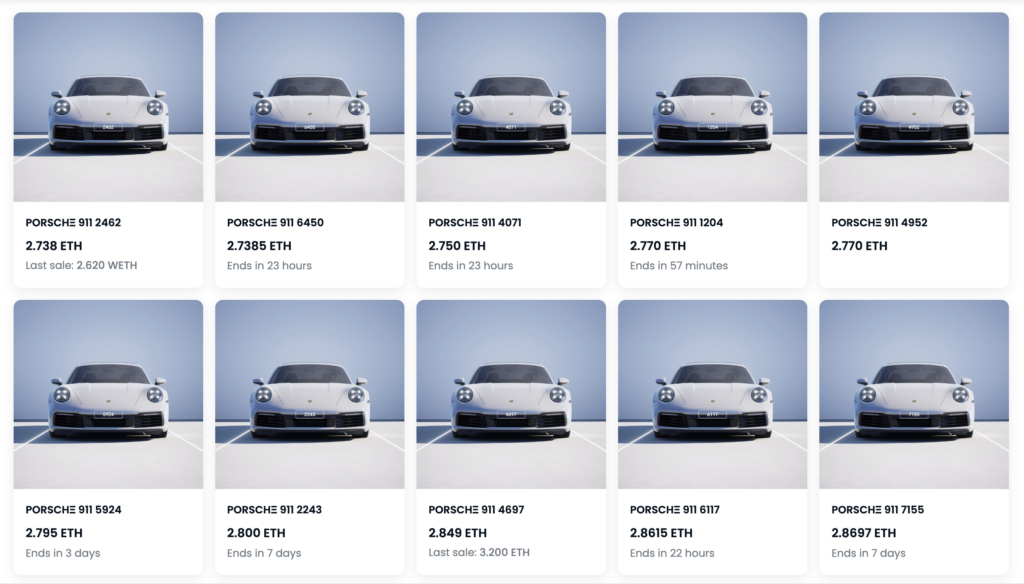After weeks of hype, Porsche’s first NFT collection ended up a humiliating flop for the German luxury automaker, achieving a meager 16 percent sell-through rate and igniting widespread community backlash. Although there is a range of opinions on why the NFTs failed to mint out, the high price of the 7,500-strong collection (0.911 ETH each, or approximately $1,412), and poor communication from the Porsche team are two widely cited factors. And although the floor price has recovered somewhat on the secondary market, the release has been widely panned, with NFT enthusiasts taking to social media to criticize Porsche’s foray into Web3 as a cynical cash grab.
If a brand as venerated as Porsche is susceptible to such negativity when branching into the world of NFTs, what lessons can cultural organizations — many of which are planning their own Web3 extensions in 2023 — learn? Although the Porsche story continues to develop, three elements stand out:
1.) Nail the Price-to-Perk Ratio
Although NFT collectors have shown they are more than willing to shell out big bucks for hyped drops, whether they depict garish cartoon apes or pieces of fine art, they are arguably more price-sensitive than ever in the current “crypto winter” climate. Porsche’s NFTs likely failed to fuel enthusiasm due to a relatively high price with little upside to the buyer.
Unlike a Bored Ape Yacht Club NFT, for example, which grants its owner membership to the BAYC “Yacht Club,” or a Prada Timecapsule NFT that includes the physical version of the item depicted in the digital asset, Porsche’s NFT simply came with a vague promise to give buyers access to future events and exclusive merchandise. Clearly, this — despite Porsche’s powerful brand name — met with a collective shrug.
The takeaway for cultural institutions? Understand the type of perk that your audience truly cares about and work backwards from there. Had Porsche’s NFTs come with an incentive to give holders some form of membership card with real benefits besides the occasional IRL event, enthusiasm may have been higher among Porsche enthusiasts from outside the NFT community.

High prices and low-level perks added up to muted enthusiasm for Porsche’s NFT release. Image: OpenSea
2.) Communication Is Key
Another reason Porsche’s NFT release fell flat is poor communication from the Porsche team, leaving audiences confused or upset and dampening demand. In response to the widespread criticism of the release, Porsche’s official Twitter account posted two tweets, first saying that the supply would be cut and that the mint will be stopped, then an hour later, stating that the mint was still open and would close on January 25, adding, “For our holders, we can’t wait to define the future with you.”
NFT enthusiasts slammed Porsche’s inconsistent communication and decision to stop the mint prematurely yet not immediately. As Rug Radio co-CEO Farokh Sarmad wrote on Twitter, “Whoever is running @eth_porsche, you’re not helping the @Porsche brand and you suck.”
The takeaway for cultural institutions? In the run-up to — and absolutely during — a Web3 initiative or NFT drop, communicate early and often and do not ignore negative feedback.
3.) Don’t Go It Alone
Another area of criticism for Porsche’s NFT release was the company’s decision to essentially go it alone in terms of rolling out the release, skimping on marketing and leaving even diehard NFT lovers confused. To distribute its tokens, Porsche partnered with Road2Dreams, a subsidiary of the German digital collectible company Fanzone.
This decision attracted further judgment from enthusiasts, with Twitter user @realfrankwilder writing, “The Porsche mint is a perfect example of why even the most established brands need to partner with Web3 natives to enter the space in a real way.” Others criticized Porsche for giving interested parties no Discord access until after purchasing an NFT, and essentially “just using Twitter engagements to sell out their collection.”
While seasoned NFT collectors may have been unfazed by Porsche’s rollout, or simply disinterested, others noted that the chaotic drop could turn off less experienced buyers, or those unfamiliar with Web3. If Porsche’s aim was to attract a wide base of buyers and even entice those new to the NFT space, this release failed to achieve either aim.
The takeaway for cultural institutions? If you’re not very familiar with the Web3 space or employ “Web3 natives,” consider working with a dedicated partner who ticks both boxes. Not only will it smooth the release process, but it can also help minimize community criticism.



